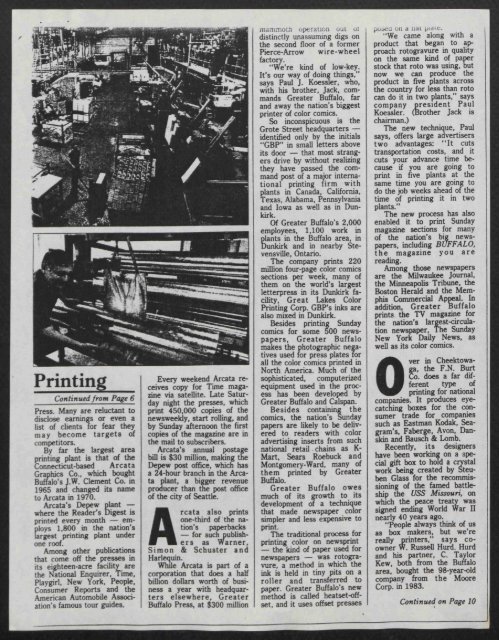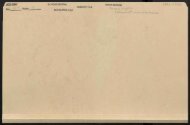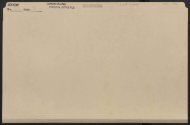invi TAT IONS - Jack Kemp Foundation
invi TAT IONS - Jack Kemp Foundation
invi TAT IONS - Jack Kemp Foundation
Create successful ePaper yourself
Turn your PDF publications into a flip-book with our unique Google optimized e-Paper software.
Printing<br />
Continued from Page 6<br />
Press. Many are reluctant to<br />
disclose earnings or even a<br />
list of clients for fear they<br />
may become targets of<br />
competitors.<br />
By far the largest area<br />
printing plant is that of the<br />
Connecticut-based Arcata<br />
Graphics Co., which bought<br />
Buffalo's J.W. Clement Co. in<br />
1965 and changed its name<br />
to Arcata in 1970.<br />
Arcata's Depew plant —<br />
where the Reader's Digest is<br />
printed every month — employs<br />
1,800 in the nation's<br />
largest printing plant under<br />
one roof.<br />
Arnong other publications<br />
that come off the presses in<br />
its eighteen-acre facility are<br />
the National Enquirer, Time,<br />
Playgirl, New York, People,<br />
Consumer Reports and the<br />
American Automobile Association's<br />
famous tour guides.<br />
Every weekend Arcata receives<br />
copy for Tirne magazine<br />
via satellite. Late Saturday<br />
night the presses, which<br />
print 450,000 copies of the<br />
newsweekly, start rolling, and<br />
by Sunday afternoon the first<br />
copies of the magazine are in<br />
the mail to subscribers.<br />
Arcata's annual postage<br />
bill is $30 million, making the<br />
Depew post office, which has<br />
a 24-hour branch in the Arcata<br />
plant, a bigger revenue<br />
producer than the post office<br />
of the city of Seattle.<br />
Arcata also prints<br />
one-third of the nation's<br />
paperbacks<br />
— for such publishers<br />
as Warner,<br />
Simon & Schuster and<br />
Harlequin.<br />
While Arcata is part of a<br />
corporation that does a half<br />
billion dollars worth of business<br />
a year with headquarters<br />
elsewhere, Greater<br />
Buffalo Press, at $300 million<br />
mammoth operation out oi<br />
distinctly unassuming digs on<br />
the second floor of a former<br />
Pierce-Arrow wire-wheel<br />
factory.<br />
"We're kind of low-key.<br />
It's our way of doing things,"<br />
says Paul J. Koessler, who,<br />
with his brother, <strong>Jack</strong>, commands<br />
Greater Buffalo, far<br />
and away the nation's biggest<br />
printer of color cornics.<br />
So inconspicuous is the<br />
Grote Street headquarters —<br />
identified only by the initials<br />
"GBP" in small letters above<br />
its door — that most strangers<br />
drive by without realizing<br />
they have passed the command<br />
post of a major international<br />
printing firm with<br />
plants in Canada, California,<br />
Texas, Alabama, Pennsylvania<br />
and Iowa as well as in Dunkirk.<br />
Of Greater Buffalo's 2,000<br />
employees, 1,100 work in<br />
plants in the Buffalo area, in<br />
Dunkirk and in nearby Stevensville,<br />
Ontario.<br />
The company prints 220<br />
million four-page color comics<br />
sections per week, many of<br />
them on the world's largest<br />
letterpress in its Dunkirk facility,<br />
Great Lakes Color<br />
Printing Corp. GBP's inks are<br />
also mixed in Dunkirk.<br />
Besides printing Sunday<br />
comics for some 500 newspapers,<br />
Greater Buffalo<br />
makes the photographic negatives<br />
used for press plates for<br />
all the color comics printed in<br />
North America. Much of the<br />
sophisticated, computerized<br />
equipment used in the process<br />
has been developed by<br />
Greater Buffalo and Calspan.<br />
Besides containing the<br />
cornics, the nation's Sunday<br />
papers are likely to be delivered<br />
to readers with color<br />
advertising inserts from such<br />
national retail chains as K-<br />
Mart, Sears Roebuck and<br />
Montgomery-Ward, many of<br />
them printed by Greater<br />
Buffalo.<br />
Greater Buffalo owes<br />
much of its grol,vth to its<br />
development of a technique<br />
that made newspaper color<br />
simpler and less expensive to<br />
print.<br />
The traditional process for<br />
printing color on newsprint<br />
— the kind of paper used for<br />
newspapers — was rotogravure,<br />
a method in which the<br />
ink is held in tiny pits on a<br />
roller and transferred to<br />
paper. Greater Buffalo's new<br />
method is called heatset-offset,<br />
and it uses offset presses<br />
On a iiat pia! e.<br />
"We came along with a<br />
product that began to approach<br />
rotogravure in quality<br />
on the same kind of paper<br />
stock that roto was using, but<br />
now we can produce the<br />
product in five plants across<br />
the country for less than roto<br />
can do it in two plants," says<br />
company president Paul<br />
Koessler. (Brother <strong>Jack</strong> is<br />
chairman.)<br />
The new technique, Paul<br />
says, offers large advertisers<br />
two advantages: "It cuts<br />
transportation costs, and it<br />
cuts your advance time because<br />
if you are going to<br />
print in five plants at the<br />
same time you are going to<br />
do the job weeks ahead of the<br />
time of printing it in two<br />
plants."<br />
The new process has also<br />
enabled it to print Sunday<br />
magazine sections for many<br />
of the nation's big newspapers,<br />
including BUFFALO,<br />
the magazine you are<br />
reading.<br />
Arnong those newspapers<br />
are the Milwaukee Journal,<br />
the Minneapolis Tribune, the<br />
Boston Herald and the Memphis<br />
Commercial Appeal. In<br />
addition, Greater Buffalo<br />
prints the TV magazine for<br />
the nation's largest-circulation<br />
newspaper, The Sunday<br />
New York Daily News, as<br />
well as its color comics.<br />
0 ver<br />
in Cheektowaga,<br />
the F.N. Burt<br />
Co. does a far different<br />
type of<br />
printing for national<br />
companies. It produces eyecatching<br />
boxes for the consumer<br />
trade for companies<br />
such as Eastman Kodak, Seagram's,<br />
Faberge, Avon, Danskin<br />
and Bausch & Lomb.<br />
Recently, its designers<br />
have been working on a special<br />
gift box to hold a crystal<br />
work being created by Steuben<br />
Glass for the recommissioning<br />
of the famed battleship<br />
the USS Missouri, on<br />
which the peace treaty was<br />
signed ending World War II<br />
nearly 40 years ago.<br />
"People always think of us<br />
as box makers, but we're<br />
really printers," says coowner<br />
W. Russell Hurd. Hurd<br />
and his partner, C. Taylor<br />
Kew, both from the Buffalo<br />
area, bought the 98-year-old<br />
company from the Moore<br />
Corp. in 1983.<br />
Continued on Page 10




